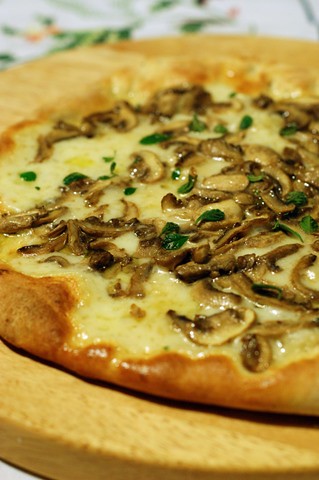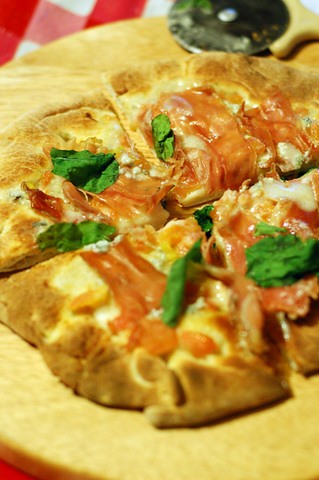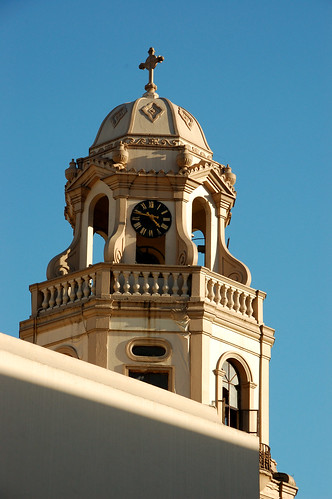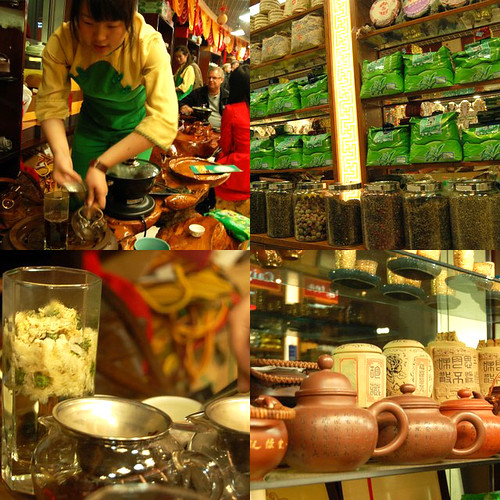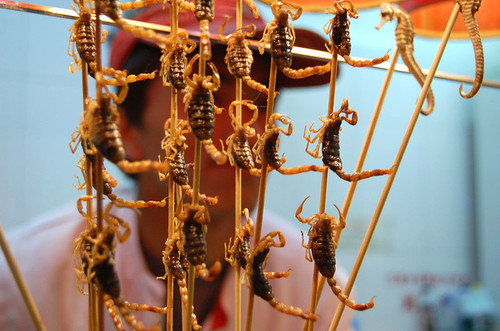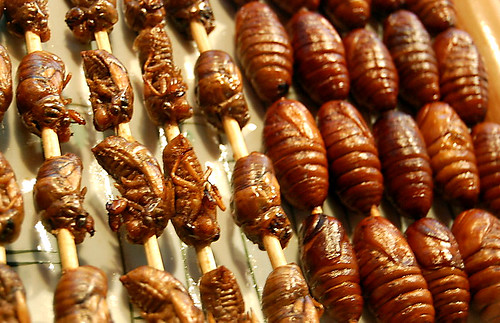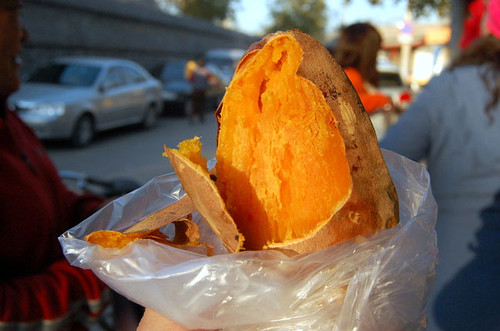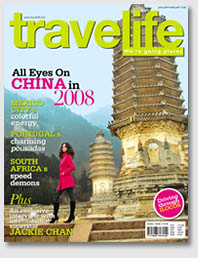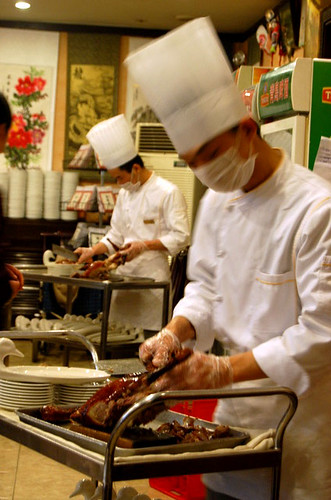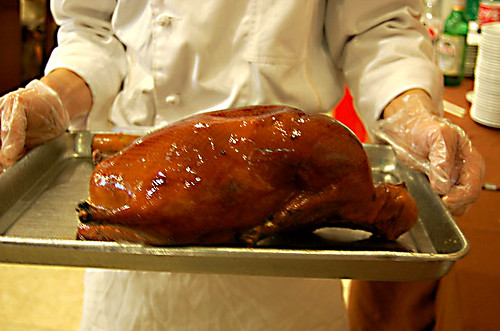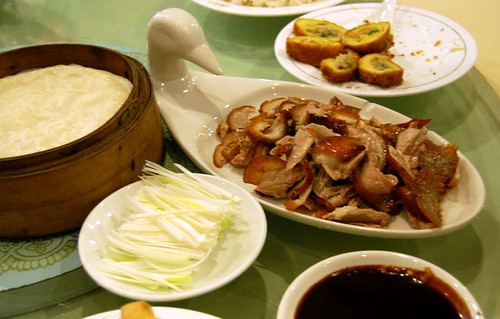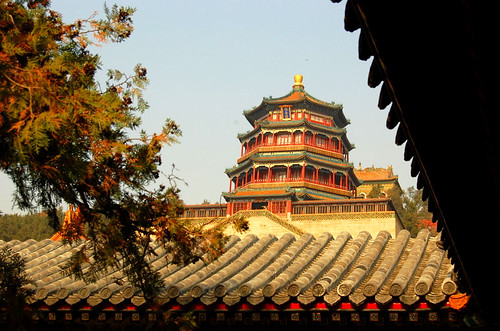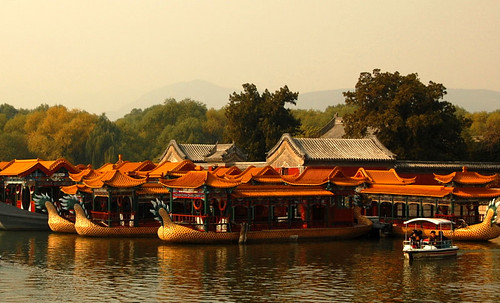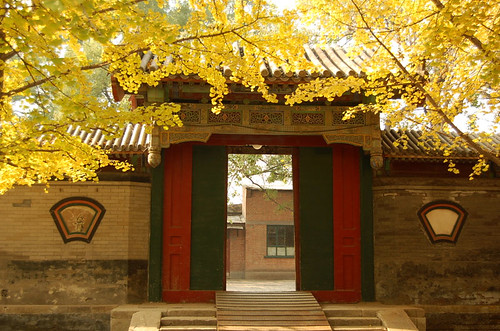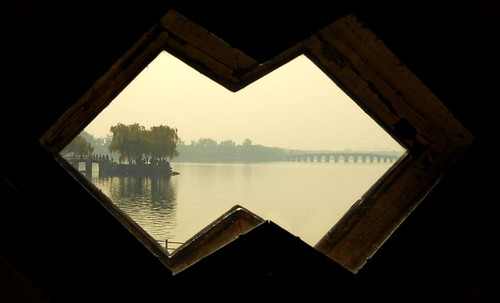January 29, 2008
HHDD #17: Mushroom provolone pizza with truffle oil
But enough with the excuses! I made a promise and I'm happy to say I kept my promise. Yay! Yay! for me! :)
I was really excited to find out that this round was about pizzas - a big favorite of mine! Though I have certain favorites from popular pizza chains and Italian restaurants around town, none can compare to the joy of making your own. I love it's versatility, which is why I also love pasta and salads so much. You can let your imagination go wild in creating your own unique flavor. Pizza dough is like a blank canvass, and you are the artist. And while I've made my share of pizzas in the past, fooling around with different ingredients for toppings, I can't say I've ever made my own pizza dough. But I wanted to! And what better time than now.
Because the event is a homage to Donna Hay, whose cookbooks and magazines are virtual eye candy - such gorgeous food styling! - and whose recipes are simple enough to make an amateur in the kitchen like me seem like a pro, I used her recipe for basic pizza dough. I'm glad I did because it was easy and perfect.
Mushroom Provolone Pizza with Truffle Oil
To make the pizza dough
(pizza dough recipe from Modern Classics I by Donna Hay)
1 tsp active dry yeast
Pinch sugar
2/3 cup warm water
2 cups plain flour; (I used unbleached bread flour)
1 tsp sea salt
1 Tbsp olive oil
Mix together the yeast, sugar, and water in a bowl. Set aside until bubbles form. Add the flour, salt, and oil, and mix to form a smooth dough.
Knead dough on a dry surface with lightly floured hands until dough is smooth and elastic, about 8 minutes.
Place in a clean, oiled bowl, cover with plastic wrap, and let rise in a warm, dry place until it has doubled in size. Mine took about an hour.
Makes one pizza.
Note: The dough can be frozen for up to 1 month. Thaw and bring to room temperature before shaping.
To shape the dough:
(tips from The Gourmet Cookbook)
Hold one edge of the dough in the air with both hands and letting bottom touch work space, carefully move hands around the edge, as if turning a steering wheel, allowing the weight of dough to stretch round to roughly 10 inches in diameter.
Lay the dough on the lightly floured work surface or pizza peel if you're lucky to have one. Otherwise use a rimless baking sheet or in my case, a round flat wooden cheese board. Continue to work edges with fingers, stretching the dough until you get the thickness/thinness you desire.
To make the pizza:
pizza dough
Provolone cheese, thinly sliced
fresh mushrooms sliced
oregano for garnish
extra virgin olive oil
truffle oil
sea salt
freshly ground black pepper
Place your baking stone in the lowest rack of a preheated oven (425 deg), allowing it to warm up for about 10 minutes.
In the meantime, brush some olive oil lightly on the flattened dough. Transfer this onto the hot pizza stone and let it parbake for a few minutes, just until edges start to turn golden. Maybe around 2-3 minutes.
Saute the mushrooms in olive oil and set aside.
Remove parbaked pizza dough from oven. Arrange cheese slices on top then scatter the sauteed mushrooms above the cheese. Sprinkle with sea salt and grind some black pepper over the pizza and return to the oven to bake a little more. Once the cheese has melted and the crust is crisp and golden, about 6-8 minutes or more. Remove the pizza from the oven, garnish with fresh oregano and drizzle with truffle oil.
The pizza couldn't have been more perfect! Everyone (mom, dad and sister) gushed after taking the first bite, exclaiming how good it was and asking for more. I quickly hid two slices in the fridge (to be reheated at work tomorrow) and watched them clean up the rest. I was happy. :) They aren't easy to please, especially my mom!
The provolone was the ideal vessel for these ingredients, mild enough that it didn't interfere with the aroma and flavor of the truffle oil, and it melted nicely over the crust allowing the mushrooms to sink deliciously into its arms. The crust was just the right crispness, thanks to the pizza stone.
Thanks, Joey! And congratulations on the previous win and for hosting this round! :) And thank you too, Barbara, for conceptualizing such a successful food event!
------
Below, is another pizza I made using the same pizza dough recipe, with crushed tomatoes as the base, and sliced apples, gorgonzola, prosciutto and arugula as toppings. It's a copycat of a pizza I tried at the La Lucciola restaurant in Bali last year. I loved it, which isn't surprising because I love aurgula and gorgonzola, so I vowed to try and replicate it someday.
You can see the original pizza if you click here. Instead of tomato sauce, I used fresh seeded and crushed tomatoes with basil as the base. You can tell from the dark-browned edges I left it in a tad too long but it was still delicious with a good crunch. I'd definitely make this again!
January 28, 2008
WS #21: Quiapo Church bell tower
I missed far too many Weekend Snapshots already which I felt pretty bad about so I decided I wasn't going to miss this one. Here is a picture of the Quiapo Church's bell tower taken during Carlos' North Bank walking tour. The church, also known as the Basilika ng Nazareno, is the home of the Black Nazarene - a life-sized statue of a kneeling Jesus Christ. On January 9 each year, the statue is taken outside for a frenzied procession during which hundreds of thousands of devotoees try to touch the image, hoping for a miracle and to be absolved of their sins. As you can come to expect from blind faith of this magnitude, the procession often results in mass injuries and even deaths.
facade of the Quiapo Church
In relation to this post, you may be interested in seeing Sidney's stunning photography of this year's procession here. Sidney, you are one brave man! :)
January 25, 2008
Silk Street & Street food
Silk street, as it turns out, isn't a street lined with stalls selling silk products. What started out as an outdoor alley market (reason for the name) is now touted as the third most popular tourist destination in Beijing after The Great Wall and the Forbidden City. It is a seven-level building crammed with thousands of retailers selling anything and everything under the Chinese sun. One level is dedicated to bags, luggage and wallets, lovely silk and silk products are found on another level, and scattered everywhere else are jewelry, antiques, shoes, electronic gadgets, toys, Chinese handicrafts, tea, art and calligraphy, clothes, beddings and table cloths, and trinkets galore.
"Do you know how to bargain?", Kevin, our guide, asked before dropping us off.
"Yes, of course! We're from the Philippines!", came the reply from our group.
"Ok, how do you bargain with them? How much?", He was testing us, not convinced we were prepared for the jungle in there.
" Hmm, maybe down to about, well, about 50, 60 percent?", my friend answered.
"Ohh no no no!", we failed his questioning, "You must bargain down to ten percent!!"
"Ten percent?!", we cried."Yes! I once bought a bag worth 900 rmb for 90 rmb".
I groaned inwardly, this is gonna be a long day. You see, I'm not very good at haggling. I don't have the patience needed to get the best bargain. And so I usually leave feeling I could have gotten it for less and then feeling cheated. It all seems so silly to me. If you're willing to sell that to me at this low price, then offer it to me at that price already and I'll buy it! Let's save each other some time. But even though I may not be good at it, I enjoy the banter so I play the game.
But here in Silk Street, the game takes on a different form. Only jungle rules apply. Walking through the aisles is like walking by restless growling lions in their cages. The vendors are hollering, clawing at your direction from their tiny stall, you can almost see the froth forming in their mouths, hungry for the kill. And should you manifest the slightest sign of weakness, even a quick glance at their direction can be misread as interest, you will be tackled and manhandled.
If you come out alive, there are other points of interest in this mall worth checking out. On one of the upper levels is a fascinating demonstration on how raw silk is produced from the cocoons of silk worms. I found a video of the process here. Funny, it's the same lady from my pictures, she's even wearing the same clothes!
various stages of silk
But where I spent most of my time was at this tea shop. At some point, my friends and I decided to split up and meet at by the entrance at a designated time. I love tea and I drink it like water sometimes, especially in the office, so I intended to bring some back with me from China. I wandered into the Tea Center and marvelled at the wide array of both loose leaf and bagged varieties. A kind saleslady invited me to sit for a tea tasting, and I happily obliged. She turned on the kettle, scooped up tea from bags and jars and tins, steeped them, strained the leaves, poured them into tiny cups, rinsed the cups in boiling water, handling them with metal tongs, scooped up some more, steeped, strained, poured. All this was done on a ceremonial wooden tasting table.
Tea drinking in China is a way of life. And witnessing this ritual and taking part in their tea culture was really special. I left carrying 2 big bags filled with green tea, blooming jasmine tea, fruit tea, 8 Treasures, and ginger tea. I also bought some tea cups and infuser mugs. Because all this wouldn't fit in my suitcase and I didn't want it getting crushed, I was forced to purchase a nice red trolley bag which was quite a steal.
Some tips for your silk street experience:
1. Bring cash. Both local currency and US dollars are accepted. Most vendors don't accept credit cards and there are few ATM's which aren't very reliable.
2. Walk away. After you're given the price of an item, simply thank the sales person then walk away. This simple act will guarantee a big drop in price, sometimes even a quick 50% drop.
3. Strength in numbers. Shop in groups if possible. If you buy more, you will be offered the wholesale price.
4. Don't expect authentic goods here. This is knock-off country so you might want to consider what you're taking through customs later on and if it's worth the risk.
5. Canvass. Don't buy from the first stall you go to. Make your rounds first, there are many stalls selling the exact same items at a possibly lower price.
6. And lastly, be firm.
Beijing Street Food:
A stone's throw away from our hotel is Wangfujing Rd., a pedestrian-only shopping street where you can find big department stores. I imagined what Oxford st. in London , supposedly the longest shopping street in Europe, would have been like if it were like this. I thought it was really nice not to have to worry about crossing the street and getting hit by a crazed Chinese driver and more importantly, not to be subjected to their fatal fumes.
The real gem though is the open-air market on Wangfujing Snack St., also known as Donghuamen Night Snack St. You can't miss it's ornate archway next to the Wangfujing Shopping Mall. We spent one evening just leisurely perusing all the food items which ran the gamut from traditional to exotic. First there were the 'normal' stuff: vacuum-packed bags of roast duck, chestnuts in abundance, candied fruit, corn, fried and steamed dumplings, grilled squid, veggie rolls, stinky tofu, fish balls...then it starts to get a little bit funkier: offal on sticks, entrails, and basically every conceivable animal part - feet, tongue, neck, ear, eggs, - it was starting to feel like a biology field trip. And then it's full-on Fear Factorish. I find myself staring at skewered scorpions and (horrors!) seahorses! The poor things!
As I'm gawking at the display, obviously mortified, the guy behind the counter decides that it would be hysterical to freak me out by flashing a live scorpion at my face. I should have seen it coming, because I knew he was watching the expression on our faces, but I didn't and let out a shriek which pleased him tremendously as evidenced by the chuckling and snortling from his direction. I glared at him.
It comes as no surprise that the Chinese eat every part of anything that moves without wheels and engines. In a country of 1.5 billion people, they had to be practical to survive, leaving nothing to waste. I have no doubt that if I were raised in China, I'd be munching on these snacks like they were buttered popcorn. But I wasn't. And neither were my friends who were with me. And so I regret to report that I didn't try any silkworms or scorpions or seahorses. Maybe next time when I'm with someone more adventurous than I am, I'd most likely give it a try. What I did love were the candied fruits ( more on this in the Xiamen series coming-up), the assorted dried fruits and nuts which we stuffed ourselves silly with and the grilled sweet potatoes!
I'll be posting pictures of more Chinese food next, in what is (I think) my final post on Beijing. So stay tuned! :)
My favorite vegetable in the world - yummy sweet potatos are grilled on the streets
January 22, 2008
A new glossy and my first article!

Last weekend was a special one. Not only did Joey and I successfully co-host a super enjoyable and delicious baby shower for one of my bestest friends in the world (yay, Jo! We make a great team if I may say so myself! :)), but it was also the weekend that the latest issue of Travelife (Jan-Feb) hit the stands. The issue that holds my first-ever published travelogue! :)
It's a piece about my trip to Mexico which they've laid out nicely over 6 pages. Clicking on the cover above will take you to an image of the first page, a sneak peak of the article. If you haven't already had the pleasure of browsing it's pages, Travelife is the hottest new bi-monthly lifestyle and travel glossy in town. It's editor-in-chief is none other than Liza Ilarde, a big name in the business for over a decade.
It's about time we have a locally-produced travel magazine of this caliber. Not too long ago, I cancelled my subscription to Conde Nast Traveller because it was just becoming too expensive to continue what with the other titles I already subscribe to. If I like a particular issue then I just buy it off the stands. But Travelife is a no-brainer for me, it's very reasonably-priced considering the content (P175) and it's written for the Filipino traveller.
I am both honored and humbled to have been asked to contribute to such a world-class publication and I am extremely grateful to Terrie Guittierez, Travelife's managing editor whom I had the pleasure of meeting at the magazine's launch party, for her kindness and patience with this newbie contributor. I really appreciate it, Terrie! :)
The latest issue has some really fascinating stories that you should check out, written by passionate travellers on dream destinations such as: Portugal: with it's countryside inns, vineyards, and port cellars; South Africa; Beijing, and Ilocos (which I'm actually scheduled to visit very soon!).
For subscriptions to Travelife, call (+632) 892-2620.
January 21, 2008
Peking duck at the source
Now what would a trip to Beijing be without a Peking duck experience? It's unthinkable. It's like being there and yet not climbing the Great Wall.
There's something special about sampling your favorite food right in it's birthplace where we can safely assume that only local ingredients are used and that it is prepared in the traditional method. The fact that you are eating among locals and in an authentic setting heightens the whole experience that much more. So while I've had my share of roast duck from Peking Garden in Manila (once a favorite for very special occasions) and Chinatowns both here and abroad, I felt as if I was about to try it for the first time. Peking duck in Peking (now Beijing)! Oohh, I couldn't wait!
There are, of course, several places in the capital where you can enjoy this feast fit for emperors. During the Ming Dynasty, cooks from all over China travelled to the capital to cook for the emperor and many of the recipes invented in the palace kitchen, such as the Peking duck, eventually made it's way to the streets where it was smuggled by the court chefs and prepared in their new restaurants. Among the most popular are Quanjude Roast Duck Restaurant and Da Dong. While the latter was personally recommended by Bee and hence was my preference, a roast duck lunch in one of the many Quanjude Roast Duck branches was already included in our tour.
The restaurant was already packed when we arrived, and several chefs were were out on the floor busy carving the shiny roasted ducks for their diners. I quickly noted that we were the only foreigners there, or at least it seemed that way, which to me is always a good sign. We were led upstairs to another dining area to a large round table reserved for our small party of four. Our pre-ordered food arrived shortly after we were seated. There was a plate of sweet and sour pork, a plate of shiitake mushrooms with bokchoy which I adored and some breaded egg rolls. And then it arrived. The Pièce de résistance.
Wheeled to us was the duck, in all it's shining glory. Like an oiled-up body builder flexing his ab muscles, the duck poufed it's crisp, fatty skin for us. I felt my salivary glands kick into 4th gear. After he presented it to us, the chef lay it down on his pushcart and began to skillfully carve the bird, ensuring the perfect balance of skin with a bit of meat- crunch & succulence- in each piece.
Preparing a duck for roasting involves the process of pumping air under the skin to separate it from the meat. The chef then meticulously massages the skin to make sure it is evenly loosened and there are no holes which might allow air to escape. The duck is basted with hot water to tighten the skin, dried and basted again with a sweet mixture before it is hung to dry, a process that ensures a crisp skin . The cavity of the duck then gets stuffed with a secret blend of spices before it's left to roast over a wood-fuelled fire.
We were served Peking duck 'three-way', in three courses. Naturally, the first (above photo) is my favorite because it involves the outer layer of the duck - the skin! A waitress lays the slices of duck on the table with a plate of slivered scallions, the steamed pancakes and hoisin sauce. She proceeds to demonstrate how to assemble the pieces together in a nice roll with her chopsticls. There must be different ways to put this together, but how I like to do it is to spread hoisin sauce down the middle of the pancake with a spoon, add the duck and some scallions, drizzle a tiny bit more hoisin, then fold the bottom part of the pancake up and over before folding in the 2 sides toward the middle. The small bottom fold helps prevent the sauce from dripping onto your shirt. The hoisin sauce here isn't as sweet as the ones I'm familiar with but I liked it just as well. I could almost hear my arteries groaning with each bite, but they were drowned out by the crunch. It was exquisite and I couldn't get enough of it!
Tougher times have taught the Chinese to use up every part of the duck, not letting anything go to waste. So after the duck is nicely carved in your presence, it is returned to the kitchen where the remaining meat - that which is not attached to any skin - is thrown into a stir-fry while the bones are used for a consommé of duck broth; the second and third courses in the Peking duck three-way. We tried these as well, but we kept going back for the wraps.
So I climbed the Great Wall and I had Peking duck at the source. My Beijing experience was now complete. Well, almost.
If you haven't yet tired of my 2 month-long series on Beijing, please stay tuned for my last two posts - some Beijing street food and more on the dining scene. :)
January 10, 2008
Breezing through the Summer Palace
Sadly, I can't say we did much of that. I had trusted that we would be given ample time to make the most of our tour but our guide seemed to be impatiently herding us around like cattle (prompting me to swear for the eleventeenth time to never again hire a guide if I can help it!). If we hadn't insisted on going up to the Tower of Buddhist Fragrance (above), we would not have gone in to see anything at all and just walked the perimeter of the grounds by the lake. Our guide barely even explained anything to us while we were there. Thankfully I did a bit of homework the night before and read my NG Traveller China guide before going to bed so I wasn't entirely clueless.
But frustrations aside, to say that I was impressed by this imperial wonderland of a retreat would be the mother of all understatements. It is the quintessential example of harmony between man and nature, seemingly designed to offer magnificent views from just about every spot. Also known as Yiheyuan, the Summer Palace was concieved in the 12th century and is touted as the best imperial garden in China. The Empress Dowager Cixi embezzled silver intended for the Imperial Navy to the restoration of the Summer Palace, which was significantly destroyed during the Boxer Rebellion, and the construction of the Marble Boat.
The Long Corridor here is similar in nature to the one at the Temple of Heaven but is much longer and with more tourists. While my friends walked along the tree-shaded pavement along the water, I chose to stroll through this corridor and imagine that I was tracing the footsteps of the Empress who must have passed this way many times to reach her Marble Boat. The ceiling of the corridor is designed in the same colorful patterns that had become familiar to me after my visit to the Forbidden City.
You can see a section of the Long Corridor to the right
We climbed the steps to the Tower of Buddhist Fragrance (to the dismay of our guide because - would you believe - this wasn't part of the itinerary) and were rewarded with a splendid view of Kunming Lake. The outdoor steps were quite the treat as they were even more beautifully designed than the Long Corridor. You can imagine all the cheesy pictures we took here!
I was really looking forward to taking pictures of the 17-arch bridge as well as our group on the dragon boat that was to take us there across the lake. But unfortunately it was low-tide, so I contented myself with a cup of coffee and pictures of the moored boats. I suspect our guide was secretly happy about our misfortune because we had already wasted precious time at the Tower. He urged us to walk faster as we made our way towards the exit, but we kept stopping for pictures along the way. It was only when he told us that if we didn't hurry we might lose our lunch reservations did we finally pack our cameras away and pick up our pace.
A half-day tour of the Summer Palace is not enough, you need a whole day here at least. For a more enjoyable and memorable visit, go on your own. You can bring a guide to help you identify the important attractions and the stories behind it, or you could also opt to rent one of those audio guides in your preferred language. Then you would have done the place justice, strolling and savoring, oohing and ahhing as you did so. It was, and still is, a place for recreation and leisure after all. :)
Autumn colors framed beautiful doorways and windows
the 17-arch bridge as seen through an original glass window
